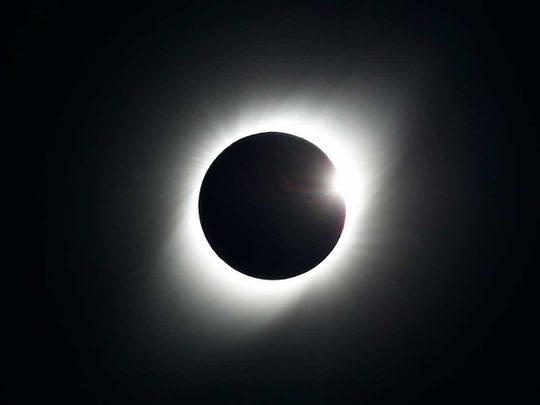
Dubai: The UAE space agency, in collaboration with the Dubai Astronomy Groups, has organised three different viewing locations to view the annular solar eclipse and ‘Ring of Fire’ on December 26. The solar eclipse occurs for the first time since 1847, where the moon will be passing in front of the sun. A partial eclipse of varying degrees will be visible around the country. The eclipse will be viewed entirely from areas around Liwa and Zayed City in Abu Dhabi.
The phenomena, which last occurred in the UAE in 1847, will stretch from Saudi Arabia in the north down to Indonesia in the southeast and back up towards Malaysia and the Philippines, but as spectacular as it is, it also comes with inherent risk explains Hassan Al Hariri, CEO of Dubai Astronomy Group.
“The sun emits intensive light, which is too [bright] for our eyes,” said Al Hariri. “So, if we look at it without protection, our eyesight will be damaged. That is why we are asking everyone to take precautions.
“We have appropriate glasses with film that can cut out the light by 99.99 per cent so we are encouraging everyone to use these. The viewing glasses cost Dh20 and can be purchased from dubaiastronomy.com
“Get get in touch with us ahead of the eclipse in order to experience it safely,” said Al Hariri.
The three viewing locations are: Al Thuraya Astronomy Center in Mushrif Park, Dubai where the public can register to attend the venue free of charge. A partial eclipse can be witnessed from this location with a crescent view of the sun. The public will have access to telescopes and safety equipment at the venue. Over 200 guests are expected to be in attendance at this venue.
The the Abu Dhabi (Madinat Zayed) location, the ‘Ring of Fire’ will be visible entirely. The coordinated viewing will take place in Madinat Zayed Park and is a free-to-attend event for the public.
For a more lavish viewing of this historical astronomical occurrence, the Burj Khalifa in partnership with At The Top and the UAE space agency, will also be hosting a viewing. An observation deck has been setup on the 124th floor where the public can witness the event from the tallest point.
For viewers who wish to witness a live streaming of the astronomical event from the comfort of their homes, a live stream from all three locations will be available on the Dubai Astronomy Group’s YouTube channel.
Eclipse can be observed on December 26 from 7:35:21am until 8:52:34am.
Safety viewing equipment:
• Glasses with special film that cut 99.9% of light
• Telescope with filters and metallic parts
• Binoculars with filters
Do NOT use:
• Regular sunglasses
• Camera lens
• Telescope with no filters
• Car tint
7 facts to know about the UAE’s ‘Ring of Fire’
1) Why do we get the ring of fire: The reason, according to ScienceAlert.com, is due to the distance of our planet’s satellite. The Moon is currently closer to its apogee – the point in its orbit furthest away from Earth – that makes it appear three per cent smaller than the Sun when viewed from Earth.
2) A solar eclipse always comes within approximately two weeks of a lunar eclipse, and usually in a single pair, one solar and one lunar. The annular solar eclipse will take place on December 26, 2019, while a Penumbral Lunar Eclipse will happen on January 10, 2020, says earthsky.org.
3) The annular eclipse will be seen in many places across the world, including Saudi Arabia, Philippines, Indonesia, parts of eastern Africa and northern Australia. The Birla Industrial and Technological Museum (BITM) said although the ring of fire will not be seen in all areas of India but from places like Kannur in Kerala and along the southern coast of the country.
4) The annular eclipse will last almost two and a half hours in the UAE. The actual eclipse when the moon is fully in front of the sun covering a maximum 91.93 per cent of its face, will only last two minutes 47 seconds from 7.35am to 7.38am, for those watching in Liwa. Even those watching from outside the full eclipse coverage area will still witness 87.18 per cent partial eclipse.
5) The annular solar eclipse is the most dangerous of 2019. Like all solar eclipses, it is important to wear eclipse glasses as not all the Sun’s light is completely blocked. It is important to wear them all the time to prevent eye damage or blindness.
The next annular solar eclipse will be observed on June 21, 2020, when 99 per cent of the sun will be blocked very briefly by the moon. It will only be seen from the Democratic Republic of Congo, South Sudan, Ethiopia, Eritrea, Yemen, Oman, Pakistan, India, Tibet, China, Taiwan and Guam.







